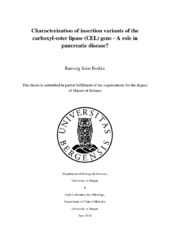Characterization of insertion variants of the carboxyl-ester lipase (CEL) gene - A role in pancreatic disease?
Abstract
Carboxyl ester lipase (CEL) is a digestive enzyme that is mainly expressed in the acinar cells of the pancreas. The CEL gene is highly polymorphic due to a variable number of tandem repeat (VNTR) region in the last exon. Diseases that are associated with CEL are related to alterations in the VNTR region. Single base insertions in the VNTR cause a premature stop codon and a truncated protein. It is not clear whether these insertions are linked to pancreatic disease. In this study, we wanted to investigate the location of the insertions and the frequency by sequencing human DNA samples. We further aimed to test tail-specific antibodies for the normal CEL protein (CEL-WT) and the CEL insertion variants (CEL-INS9 and CEL-INS11) by western blot, immunocytochemistry and immunohistochemistry. Moreover, we wanted to study the impact of CEL insertion variants in a cellular model system, thereby evaluating if insertions in the CEL VNTR potentially could be pathogenic. We sequenced 50 human DNA samples from the Pancreas Biobank at Gade Laboratory for Pathology, Department of Clinical Medicine, University of Bergen. We noticed five cases with INS9, one case with INS10 and one case with INS12, which results in a carrier frequency of 14 %. However, we observed that the five cases with insertion in repeat 9 all had a VNTR length of 13 on one of the alleles. We further investigated this by sequencing all remaining DNA samples in the Pancreas Biobank with a 13 repeat VNTR length (N=25) and observed that in total, 23 of 31 samples had insertion in repeat 9 and a VNTR length of 13 on one of the alleles. The CEL-WT protein has a C-terminal that ends with the six amino acids, PAVIRF. However, if an insertion occurs in the CEL VNTR it results in a truncated protein and a C-terminal that ends with the sequence PRAAHG. Tail-specific antibodies have been produced towards these C-terminal ends. We tested the tail-specific antibodies by western blotting, immunocytochemistry and immunohistochemistry. The tail-specific antibodies were highly specific in the western blots, but did not display the same specificity by immunocytochemistry and immunohistochemistry. Finally, we studied the effect of insertions in the CEL VNTR on protein secretion and aggregation in HEK293 cells. We observed that the insertion variants were similarly detected in the lysate and the medium. However, we detected more of the CEL-INS9 variant, than CEL-INS11 and CEL-WT in the pellet fraction. In summary, we have shown that there is an association between insertion in repeat 9 of the CEL VNTR and a VNTR length of 13. We also found that the tail-specific antibodies had the highest specificity in western blot analysis. Moreover, our data indicated that insertions may affect the distribution of the CEL protein in different cellular fractions, thereby implicating that the VNTR region is important for the cellular properties of CEL.
